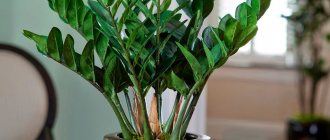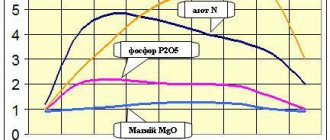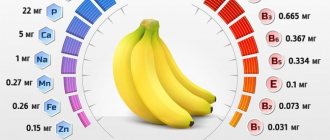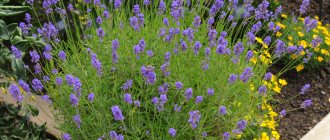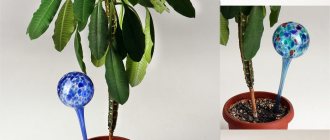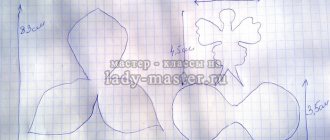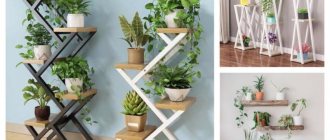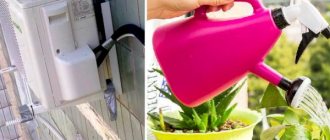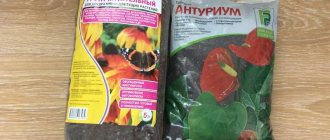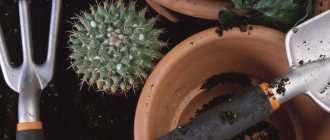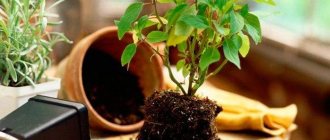When growing flowers indoors, you need to carefully take care of your green pets so that they feel as comfortable as possible indoors. It is advisable to create conditions close to the natural habitat. To do this, you will need to maintain the temperature in the room, air humidity, and also choose the right soil for the plants, which would combine exactly the qualities that this particular flower or shrub needs. Although in flower shops you can find bags of universal planting material that will suit most green pets. Read our article about what kind of soil is needed for planting indoor plants and how to correctly classify the types of substrates.
Heavy ground
This type of soil is best suited for growing large plants with a developed root system located at great depths. Among such representatives, the most common are clivias, dracaenas and palm trees. As a rule, this garden mixture is prepared from three components:
- 5 parts turf soil;
- 1 part coarse sand;
- 1 part humus.
Knowing the preferences of indoor plants regarding the quality and composition of the substrate, it can be prepared at home. All components are prepared independently or purchased at any specialized store.
Types of soils with different nutrients:
1. Ground from cut turf
(also known as Turf Soil), it is added to many soil solutions. It contains a lot of different components that are useful for flowers. Among the disadvantages, one can note its predisposition to compaction.
2. Leaf humus
(also known as leaf or foliage soil). This kind of soil is obtained as a result of the debate of fallen leaves. It contains a lot of useful components, its distinctive features: lightness, tendency to loosening. This type of soil is used for growing flowers that cannot tolerate humus consisting of manure. This type of soil is stored from the forest, taking the surface layer of the earth. The accumulated foliage is placed in piles up to one and a half meters high, the whole thing is moistened with liquefied manure, and after two years this soil is ready for use.
3. Sand from rivers
, they perform the function of loosening the earth. It is preferable to use sand consisting of large grains of sand. Also, it improves the quality of clay soils.
4. Manure humus
. Such land is formed as a result of mixing rotted manure and humus from greenhouses. Just like compost, it is laid in piles. The peculiarity of this earth is that it is very crumbly, soft and moisture-absorbing, it enhances the qualities of earthen mixtures.
5. Peat humus
- This is a crumbly, airy, well-absorbing mass that is formed due to the rotting of bog peat. This mass improves the properties of the earth. Adding it to the soil increases its subacidity, therefore it is worth carefully monitoring the level of acid, both the added mass and the soil to which it is added, and if something happens, dilute the soil with a mixture of limestone and chalk.
6. Sphagnum
, it is mixed with soil to increase its airiness, friability and ability to absorb water vapor from the air. It is worth noting that before adding, sphagnum must be passed through a sieve. Soil mixed with sphagnum is suitable for growing lilies of the valley and orchids.
Medium soil
Most representatives of indoor plants prefer this type of soil, since its composition is optimally balanced. Such a soil mixture can be made from the following components:
- 1 part peat;
- 1 part sand;
- 2 parts humus;
- 2 parts of turf land.
If you decide to prepare the substrate and soil for plants with your own hands, then it is worth noting that all components must be of proper quality. You should also observe all proportions correctly, because with the slightest mistake, the root system of your indoor pet can be affected by rot, which will be almost impossible to get rid of.
How can I check all this?
Only visually, using documents and, if necessary, taking a soil sample for testing. To do this, before ordering (especially large quantities), come to the supplier’s base or store to make sure the availability and quality of the material. You will be able to see the soil with your own eyes, touch it with your hands, and conduct an acidity test. For example, chernozem or its presence in the soil mixture is checked this way: you need to pick up a small pile of soil, realize that it is quite heavy, and squeeze it between your fingers. There will be barely noticeable oil traces on your hand, which means there is humus in the composition, and that’s good. If you buy soil in bags, ask the seller to package and pack the material in a bag of the required volume.
Light soil
This soil is best suited for growing small flowers that have a shallow root system. Popular representatives include: gloxinia, cyclamen, begonia and aloe. Also, such a substrate can be successfully used for growing seedlings and for rooting cuttings. With the standard preparation scheme, you need to mix the following elements:
- 1 part sand;
- 1 part humus;
- 1 part leaf soil;
- 3 parts peat.
Before connecting all components, it is recommended to thoroughly sift the soil to remove foreign bodies. Otherwise, small stones and twigs will interfere with the proper development of the root system. Remember that the soil must be clean, airy and loose.
Comparison
As for the other meanings of the words “earth” and “soil,” they mean a variety of things and abstract concepts. When talking about the motives for committing a particular act, they say the phrase “committed on the basis of.” And then comes the key word - motivated by hatred (most often) or love. The word “soil” in this case is used to designate a certain foundation on which strong feelings grow that can push both to feat and to crime. This is an example of an abstract application.
“Earth”, in addition to those listed above, has a number of meanings used to name a variety of things. This is a profound word, which from time immemorial has meant a lot to agricultural peoples. Therefore, it is not surprising that this is the name of four feature films, three studio albums of various musical groups, and a rural newspaper published in Transbaikalia. In addition, “earth” is a letter of the old Slavic Cyrillic alphabet, and electricians also have a slang name for grounding. At this point, perhaps, we can put an end to the conversation about what is the difference between earth and soil.
Many people are concerned about the issue of rational use of their own fertile lands. Some are engaged in agriculture, others are engaged in landscaping and landscaping. It’s great if you live in a picturesque and fertile place, but what if not? Then the idea of purchasing soil and updating it will be an excellent way out.
This is one of the popular types of soil. Main composition: peat, soil, sand, fertilizers.
Depending on the manufacturer and purpose of use, the percentage of parts may vary. There is a type of plant soil that is not mixed, but simply a high-quality layer of soil cut from the field.
Used to improve soil fertility and structure. Performs a protective function, intertwined with the mulching effect. Creates a good water-air effect. This significantly improves clay soil with poor drainage structure.
Substrate structure
The characteristics of soil for indoor plants include two main parameters that you should pay attention to first - acidity and structure. The composition of purchased substrates can be very different. It is simply impossible to determine by eye whether the contents of the packages correspond to the composition indicated on the packaging. In this regard, when assessing the quality of the proposed substrate, it is necessary to focus on easily recognizable and always visible characteristics, for example, the presence or absence of structure.
The soil for indoor plants (flowers, vines, shrubs, etc.) should have a pronounced structure, that is, the presence of some rough texture, heterogeneity and lumps. This can be easily checked by feeling the substrate bag with your hands. In such soil, plants will never suffer due to dry “layers” that form on the surface of the flowerpot as a result of soil drying out. In soil with a pronounced structure, moisture will be evenly distributed and retained in any part of the substrate. It also retains its breathability even several years after planting, since the upper layers of the soil are not corroded and compacted. At the same time, substrates that have a too uniform composition are more prone to acidification, as well as uneven distribution and retention of moisture.
How to choose and buy good soil
According to labeling requirements, the packaging of the finished soil must contain the following information:
- legal name, address and telephone number of the manufacturer,
- purpose of the soil,
- date of manufacture, batch number, shelf life and conditions,
- transportation requirements, hazard class and rules for safe use,
- packaging volume,
- chemical composition.
In addition, many manufacturers indicate the acidity and content of nutrients in the soil.
Since the store cannot open the package and check its contents, all that remains is to carefully examine the packaging.
A conscientious manufacturer does not hide anything. Everything required by law and additional information, such as advice on how to use the product, is indicated on the packaging. If some important information is missing, this is a reason to think about the quality of the product. Most likely, such soil is counterfeit, so buying it is dangerous.
After purchase, you can open the package and carefully examine the soil mixture.
High-quality soil, depending on its composition, must, firstly, be of the correct color: high-moor peat, black soil and humus - rich brown, lowland peat - dark brown. If the soil has a light gray tint, this indicates its depletion, red inclusions indicate the presence of clay, and a brown color indicates increased acidity of the soil.
Rub the soil in your palm and check if the lumps break easily. If there are a lot of lumps and they are too hard, most likely it is a caked substrate that will be difficult to work with. Consider the fine fractions. There should be no seeds, pebbles, roots, branches or other debris. Check carefully for earthworms or other insects in the soil.
You can identify bad soil by smell. Perhaps everyone knows what the earth smells like - light dampness with a slight bitter taste. If the smell from the bag is too strong or chemical, it is better to throw away this soil mixture.
The moisture content of the finished soil is also important. It should be neither too dry nor too wet.
[!] Sometimes the humidity of the finished soil is so high that mold grows in it, visible to the naked eye immediately after opening the package. Such soil should be thrown away immediately.
Before planting seeds, experienced gardeners even check the acidity of purchased soil, since the acid-base balance of the environment is very important for plants. The easiest way to do this at home is with a tester - litmus paper. Another way is to water the soil with 9% vinegar. If abundant foam forms, the soil is alkaline; there will be no foam at all - the soil is acidic.
These are, perhaps, all the ways in which you can check the finished soil before planting. The plants will tell you the rest - in good soil they will feel great, in bad soil they will get sick.
[!] Do not immediately purchase a lot of untested ready-made soil. First purchase one package, carefully study the contents, and then, if the soil mixture is of sufficient quality, purchase the required volume.
If the substrate from the store is very bad, it is better not to waste money and get rid of it without regret. In other cases, the soil needs to be amended and used for planting seeds or replanting adult plants.
Soil acidity
Determining the composition of soil for indoor plants is not so difficult, but what to do with acidity? Even in universal substrates, this parameter must be indicated on the package with soil, since most indoor crops have their own individual characteristics, which are by no means uniform in their requirements for soil reaction. Of course, most plants will thrive in a neutral environment, but there are also representatives that develop exclusively in soil with an alkaline or slightly alkaline reaction, as well as species that require an acidic environment.
For indoor flowers, the average acidity value is 6.0 on the pH scale (neutral environment). Soils with a pH of 7.0 and above are alkaline or calcareous, and substrates with a pH of 5.5 and below are classified as slightly acidic or acidic.
Very few indoor plants prefer alkaline soil. Among the prominent representatives: chlorophytum, ophiopogon, calceolaria and bells.
Soil for indoor plants and flowers with a reaction of 5.5 pH will be optimal for cyclamen, cestrum, sansevieria, pittosporum, pachyphytus, ferns, wood sorrel, dieffenbachia, cypress, cordyline, calla lilies, camellia, gerbera, alocasia, acalypha and others. A substrate with a pH value of 4.0 to 5.0 is preferably used for bergeranthus, hydrangea, zuphorbia, oscularia, ceropegia, rhododendron, etc.
In the description of any indoor plant, in addition to the replanting strategy, as well as optimal maintenance conditions, you can find the preferred composition and structure of the soil. If you decide to determine which soil composition is best for flowers, then you should not settle for the “average” option, since for each pet you need to choose your own substrate, based on the individual preferences of a given plant. Of course, most crops will prefer a nutritious, loose and universal type of substrate with a neutral environment, however, in indoor collections there are often species for which such soil will be destructive.
Method of growing plants indoors: the basics
The ideal soil for indoor growing is easy to create using a purchased substrate. The best substrates for plants are those with humus and other organic substances. First of all, you should pay attention to the composition - the basis of the soil should be peat. It must also be enriched with micronutrients such as phosphorus, nitrogen and potassium. In this case, their proportion should be as close to equal as possible. A plus will be the presence of minor microelements in the substrate - iron, sulfur and calcium. The pH level of the soil when growing indoors should not exceed 6.5-7.
Universal primer
When choosing a soil composition for plants, you need to pay attention not only to the acidity indicator, which must be indicated on the packaging, but also to the suitability of the substrate for a particular type of plant - in most cases, the list of crops will also be given on the package with planting material. Also, do not forget that you can get advice on the suitability of a particular type of soil from a sales consultant who will help you make your choice.
A single, or universal, complex earth mixture is most often found on sale. Manufacturers can call it whatever they want - from the usual “soil” to clever brand names. This soil is considered suitable for various groups of plants due to its “average” characteristics. Most unpretentious indoor crops that do not require special care will happily live in it.
How to improve finished soil
Is it possible to improve the finished soil? Yes! There are several ways.
First of all, you should get rid of the infection, which is not necessarily, but possibly, present in the purchased land. For this soil:
- They freeze it. This method is especially convenient in winter, when the air temperature reaches 15°C and below. You just need to take the bag with soil out onto the balcony and leave it for several days. Then bring it back for a week and take it out again. The pests will die, and those that survive will be destroyed by re-freezing. If there is not much soil, you can use the freezer of the refrigerator.
- They are calcined. A method that is almost guaranteed to rid the soil of various types of contamination. A thin layer (no more than 3-4 cm) of earth is scattered on a baking sheet and then placed in an oven preheated to 90°C.
- Steamed. This is a gentler, but also more labor-intensive procedure than calcination. The soil is poured into a colander and kept over a container of boiling water for about ten minutes. In this way, the earth is not only cleared of parasites, but also saturated with moisture, which is very beneficial for plants.
- They spill. And finally, you can simply spill the soil mixture with a weak solution of potassium permanganate (no more than 5 g per 1 liter of water). This option, although simple, is not very effective - many pests are not at all afraid of a solution of potassium permanganate.
[!] When destroying parasites using one of the methods described above, remember that beneficial microorganisms will also be destroyed. The earth will become sterile, which means its fertility will have to be restored with preparations containing live bacteria and complex fertilizers.
Experienced flower growers, gardeners and gardeners most often do not use purchased soil in its pure form, but always enrich it with various additives. For example, vermiculite, perlite, coarse river sand, coconut fiber, coal, brick chips, sphagnum. The total share of such additives can reach 40% of the total soil volume.
These admixtures improve the structure of the soil, increase the water and air permeability of the soil, and make the too dense, compacted purchased soil airy and light.
What exactly and in what quantities to add depends, firstly, on the composition of the purchased soil, and secondly, on the requirements of a particular plant and the conditions of its maintenance. There are no universal recipes: in each specific case you need to follow your instincts. We can only give some general advice:
- Before using additives, carefully read the information on the packaging of store-bought soil. It is logical that if sand is already declared there, you should not pour it additionally in large quantities.
- If you want to acidify the finished soil, add some pine or spruce needles to it.
- Squeeze a handful of earth in your fist. If the soil crumbles after decompressing, you can use it. If it's compacted, it means it's too dense, add coarse sand.
- If the room where the plants are located is too humid and mold grows on the soil, increase the proportion of baking powder.
- By adding coconut fiber to the soil, you can do without additional drainage. This material almost does not decompose, does not settle and perfectly loosens the soil.
- Coal can disinfect the soil, so a little coal (preferably birch or aspen) should be added to each soil mixture.
Experiment, and you will definitely be able to find a recipe for the ideal mixture that suits your plants.
*** Of course, there is nothing wrong with ready-made store-bought soil, but you need to choose and use it wisely. So as not to destroy the plants.
Special types of substrates
Special substrates are soil mixtures developed and selected for a specific family, species or type of indoor plants. A distinctive feature of such soil is its narrow directionality. These earthen mixtures differ from universal ones not only in their structure and acidity, but also in varying degrees of nutritional value, which is achieved thanks to additional additives in the form of sphagnum or pine bark. Such compositions are always better than universal ones, since they truly satisfy all the needs of indoor crops. However, choosing this type of substrate will be extremely difficult, so first you need to familiarize yourself with information about the plant itself.
Special substrate types include:
- soil for violets;
- soil for growing indoor roses;
- substrate for tubs, jasmine, citrus;
- soils for palm trees (in rare cases you can find separate mixtures for dracaena and yucca);
- soil for succulents and cacti;
- soil mixtures for decorative deciduous and decorative flowering plants.
Moreover, ready-made soil for plants of narrow specialization is perfect for representatives who have similar soil requirements. For example, almost all Gesneriaceae will feel great in soil for violets, and soil for yucca or dracaena is also suitable for hibiscus. But orchid soil is a highly specialized substrate that can only be used for orchids.
Where is black soil used?
- In agriculture (vegetable gardens, orchards, greenhouses, farms). For a more rational approach, this fertile composition is added to the ground in a proportional ratio of 1:3.
- On construction sites, after completion, to restore the organic structure of the soil.
- In landscape design.
- In the treatment of “tired” earth.
Any soil brought to a new place, especially to a place where conditions are different, does not have the ability to retain its valuable qualities for a long time. Something is washed away by water, something is used by vegetation, something is lost due to inconsistency of natural conditions. Therefore, to obtain an annual harvest, it is necessary to update the soil every 2-3 years.
Considering that chernozem is 1.5-2 times more expensive than plant soil, and that it constantly needs to be updated, the choice of soil for the land can only be made by the customer himself.
Many problems when growing ornamental plants are related to the quality of the substrate. When growing even ordinary flowering or decorative foliage plants, pay attention to the fact that the substrate is of high quality. It retains its structure for a long time, thanks to its better buffering capacity it smooths out the negative effects of maintenance errors, frequent watering and improper fertilizing. Select the soil as carefully as you choose a plant. The savings here are quite dubious. You can save hryvnia and lose a plant for hundreds of hryvnia.
Substrate (comes from the Latin sub - under and stratum - layer, substratum) literally - litter, base, lining, nutrient medium. This concept is very broad. Used as a synonym for substance. In biology, it is a support, a nutrient medium for plants and microorganisms, the basis for the life of an animal or plant organism, the environment for its permanent residence and development. In nature, this could be mineral soil, bare rock, or forest floor.
Most often, an artificial substrate is a material or a specially prepared mixture of natural or synthetic components (except natural mineral soil) suitable for the growth and development of a plant. It mechanically secures the roots, supplies water, air and nutrients, and is intended to replace the plant’s natural mineral soil in which it grows in natural conditions. This definition refers to materials intended for growing plants in pots, containers, bags, blocks. According to linguists, the variety of words naming the phenomenon indicates its wide distribution.
In theory, everything is simple. But when it comes to purchasing specific goods presented on the Ukrainian market, a lot of confusion begins with definitions: there is no agreement between manufacturers regarding terminology. In other European countries the situation is similar. Some write “substrate” on packages with a certain composition of components, among which most often appear one or another garden soil, peat, sphagnum, sand and a complex of nutrients. Others consider only one of these components to be the substrate, for example, a certain type of peat, zeolite or mineral wool. Some companies call earth or soil products for amateurs, and substrates for professionals.
Manufacturers often call soil mixtures intended for certain types of plants substrates. So, is it still soil or substrate? We believe that these are synonyms. In everyday life, the more understandable and common definition is soil, earth, flower soil, potting soil, flower soil, and among professionals - substrate. We will use both terms to mean a mixture for growing plants in containers. New standards of Ukraine, brought into line with EN standards, use the term growth or cultivation environment (Ukrainian: medium to growth). Russian standards use the term agrosubstrate. It’s not so important what you call it, what’s more important is the essence, that is, what it is.
It is necessary to distinguish between substrate and nutrient soil. Nutritious soils contain high doses of nutrients (the content of available forms of nitrogen, phosphorus, potassium is 600 mg/l or more). Essentially these are organomineral or organic fertilizers. In their pure form they cannot be used for growing plants.
You may be surprised, but a good flower soil (read substrate) actually does not contain mineral soil (soil) at all, but is a complex composition including high-moor peat, vermiculite, perlite, composted pine bark or timber, sand, chalk or dolomite. These components must be mixed by the potting soil manufacturer in the proper proportions. Professionals call such soilless mixtures for growing plants “pure” (“soilles mixes”). This means that they do not contain processed agricultural or household waste, or any field soil. They were first developed for industrial growing of planting material as sterile and free from soil-borne plant diseases and capable of promoting rapid root growth. Today, many versions of these professional pure mixtures can be found among the best potting soils in the store. Although more expensive, quality soils will encourage the plants in your containers to grow and grow and grow just as they do in greenhouses and nurseries.
Sod land
The result of overheating of turf layers is quite nutritious soil. To prepare the substrate, you need to put the grass in a pile, then cover it with a layer of cow manure. All that’s left to do is wait until this “pie” gets overcooked. The substrate is used for planting plants that prefer acidic soils, since turf soil has an acidity of 5 to 6 pH. In order to reduce the reaction, as well as to give the substrate a looser structure, turf soil is often mixed with other types of soil, as well as sand or clay.
Recipes for soil mixtures for seedlings
The ratio of components is indicated in parts by volume.
Recipe for earthen mixture for tomatoes (1st option)
Humus (1) Peat (2) Sand (0.5)
Recipe for soil mixture for tomatoes (2nd option) Sod or garden soil (3) Humus (2)
Recipe for soil mixture for peppers (1st option) Humus or compost (2) Peat (2) Sand (1)
Recipe for soil mixture for peppers (2nd option) Peat (3) Humus (2) Sod or garden soil (1)
Recipe for soil mixture for Eggplant (1st option) Peat (2) Humus (5) Sod or garden soil (3)
Recipe for soil mixture for Eggplant (2nd option) Peat (2) Humus (3) Sand (0.5)
Recipe for soil mixture of cucumbers and pumpkins (1st option) Sod or garden soil (1) Peat (1) Humus (1) Leaf soil or sawdust (1)
Recipe for soil mixture of cucumbers and pumpkins (2nd option) Sod or garden soil (1) Humus (2) Peat (3)
When picking or transferring grown seedlings, you need to add superphosphate (30 g), urea and potassium sulfate (15 g each), and wood ash (1 cup) to the soil mixture in 1 bucket.
Leaf ground
Perhaps the lightest and loosest soil for plants. The mixture of substrate, which contains leaf soil, perfectly allows water and air to pass to the root system, but its nutritional value is at an average level, since such planting material is obtained as a result of the rotting of simple leaves from deciduous trees. They are harvested in small heaps in the fall and left for a period of one to two years. To make the process of overheating go faster, the layers of the heap must be constantly watered and turned over. Leaf soil can be used to enhance the acid reaction.
Differences in composition features
Fertile soil
enriched with a large number of nutrients, which certainly affects its high bioactivity. In composition, it has a lumpy structure and low density; it allows water to pass through freely, as it is saturated with oxygen. Fertile soil has neutral acidity and is environmentally safe.
Vegetable soil
differs from fertile in its balanced composition of the main components. Peat, sand and minerals provide it with the necessary density, ideally retain moisture and air, which has a beneficial effect on plant growth. When plant soil is added to the soil, the soil structure becomes lumpy and loose. Has neutral or weak acidity.
Peat land
This land differs from others in its particular lightness and friability. This is what is most often used to improve the overall soil composition. Peat mixture provides mineral balance for any soil mixture. It is obtained exclusively from peat, which has gone through a period of decay at least a year ago. In gardening, high-moor peat is most actively used, and less often, dark transitional peat, which has an acidity of 3.5 to 5.5 pH. If there is peat in the mixture, then you should definitely see fibrous reddish pieces in it. This soil is best suited for growing young seedlings, especially all aroids. Ferns and philodendrons can even live in clean peat. However, in order for the soil to better allow water and air to pass through, it is recommended to mix it with other types of soil.
Definitions
Soil is the upper (surface) layer of the earth's lithosphere, which has fertility and is a multifunctional open heterogeneous system of four phases (liquid/solid/gaseous plus living organisms), structurally formed as a result of the processes of vital activity of organisms and weathering of rocks.
Soil is a dynamic multicomponent system (as mentioned above, it includes rocks, sediments/soils and man-made formations), which is part of the geological environment and is considered in direct connection with engineering and economic human activity.
Those wishing to receive more detailed interpretations will be immediately referred to the relevant specialized literature, but here we will try to isolate a key point that is important for “everyday” understanding - and Ridley Scott’s film “The Martian” will help us with this. Let us recall: in the context of interest to us, the main character is engaged in the targeted transformation of Martian soil into soil, using available organic substances, water and microorganisms, ultimately achieving the manifestation of the main property of the soil - fertility in relation to the planted plant.
There is also a strict definition for the concept of “soil fertility”: this is the ability of the soil to satisfy the needs of plants placed in it for nutrients, air and moisture, as well as provide them with conditions for normal life.
In this regard, it would also be useful to mention a couple more definitions that are already in circulation in the normative literature:
- According to GOST 54003-2010, soil is either an artificially created but still fertile soil mass, or a fertile layer mechanically removed from the surface of a plot of land or brought onto it.
- According to GOST 27593-88, soil is a natural historical organomineral independent natural body formed on the earth’s surface as a result of prolonged exposure to abiotic, biotic and anthropogenic factors, including solid mineral/organic particles, air and water, and also has special genetic and morphological properties and characteristics that create appropriate conditions for the development and growth of plants.
Coniferous land
This variety of acidic light soil is perfect for growing flowering indoor plants, such as azaleas and anthuriums. The soil is the top layer of litter taken from a coniferous forest (usually pine). If you decide to prepare soil for plants yourself, then you should know that you do not need to remove the layer from the very top, since there are many unrotted needles there. It is best to use the bottom layer, which is located at a depth of 20 centimeters. This is a fairly loose soil with a reaction of 4 to 5 pH.
Differences in soil origin
Fertile soil
are obtained artificially by mixing high-moor peat (low degree of decomposition) and additional substrates (sand, black soil) in a percentage ratio of 50 to 50.
Development of fertile soil in the field
This ratio can vary significantly - the more additives in the soil, the higher its fertile properties.
Vegetable soil
It is a mixture of sand and low peat with a slight addition of minerals. It is also extracted naturally - mechanical removal of the top layer of earth.
The percentage ratio of peat to sand in plant soil is usually 60 to 40. If it is of natural origin, the presence of turf is allowed in its composition, in which case the amount of peat increases to 75%.
Bark
In most cases, gardeners use exclusively pine bark. It can be collected right in the forest. To disinfect and soften the material, boil it for 30 minutes in boiling water, after which it is cut into small pieces. The bark will give the substrate good water permeability, as well as lightness. It will also provide an acidic reaction for the mixture (4-4.5 pH). Pine bark is also used to make the soil for plants more loose. This property is especially required by aroids, ferns and, most of all, orchids.
Sphagnum (moss)
This is an indispensable component of the soil mixture for epiphytic plants. Moss is used to make the soil light, loose, and hygroscopic. However, before use, it must be dried well and then ground almost into powder. Sphagnum moss will give an acidic reaction around 4 pH. Moss is also perfect for covering the aerial roots that are located on the trunks of some plants, so that they do not dry out or freeze. It is also better to cover buried branches (during propagation) with fresh moss.
The information from the article will help you properly prepare soil for your pets and answer the question of what kind of soil is needed for planting indoor flowers. Remember that not all crops prefer to “live” in universal soil, so before replanting it is better to consult with a specialist in a flower shop or find information in the relevant literature.
